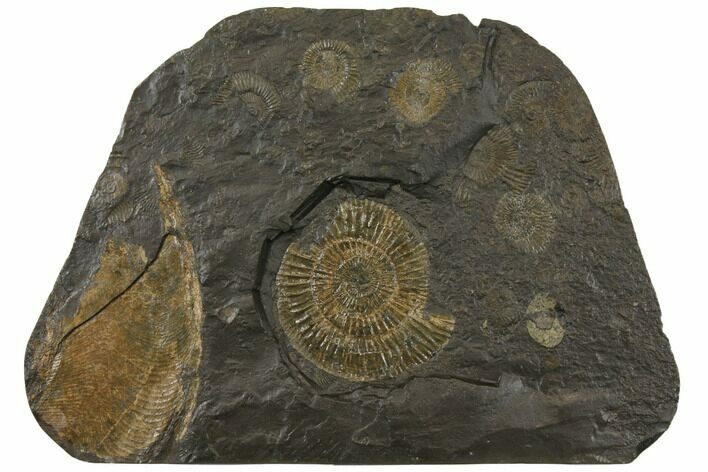This Specimen has been sold.
11.45" Fossil Ammonite (Dactylioceras) Cluster - Hanging Presentation
This is a cluster of Dactylioceras ammonites from the Posidonia Shale of Germany. They have been compressed and are preserved on a black slate in a partially pyritized state. There is a large, partial Harpoceras ammonite along the left side of the plate. The back of this specimen has been epoxied and a single nail hanger hole has been installed for hanging presentation.
About Ammonites
Ammonites were ancient marine cephalopods, similar to today's squids and octopuses, but with a defining feature: their distinctive, tightly coiled spiral shells. These shells, resembling those of modern nautiluses, served as both a protective home and a buoyancy aid, allowing ammonites to navigate the prehistoric seas with ease. First emerging around 240 million years ago in the Triassic Period, ammonites thrived for over 175 million years, adapting through numerous forms and sizes. As predatory creatures, they likely fed on smaller marine organisms, using their tentacles to capture prey. However, their long reign came to an end 65 million years ago at the close of the Cretaceous, coinciding with the mass extinction event that also eliminated the dinosaurs.
Ammonites were ancient marine cephalopods, similar to today's squids and octopuses, but with a defining feature: their distinctive, tightly coiled spiral shells. These shells, resembling those of modern nautiluses, served as both a protective home and a buoyancy aid, allowing ammonites to navigate the prehistoric seas with ease. First emerging around 240 million years ago in the Triassic Period, ammonites thrived for over 175 million years, adapting through numerous forms and sizes. As predatory creatures, they likely fed on smaller marine organisms, using their tentacles to capture prey. However, their long reign came to an end 65 million years ago at the close of the Cretaceous, coinciding with the mass extinction event that also eliminated the dinosaurs.
SPECIES
Dactylioceras
LOCATION
Holzmaden, Germany
FORMATION
Posidonia Shale
SIZE
Rock 11.45 x 7.95" Largest ammonite 3.3"
CATEGORY
SUB CATEGORY
ITEM
#129421
We guarantee the authenticity of all of our specimens.
 Reviews
Reviews












